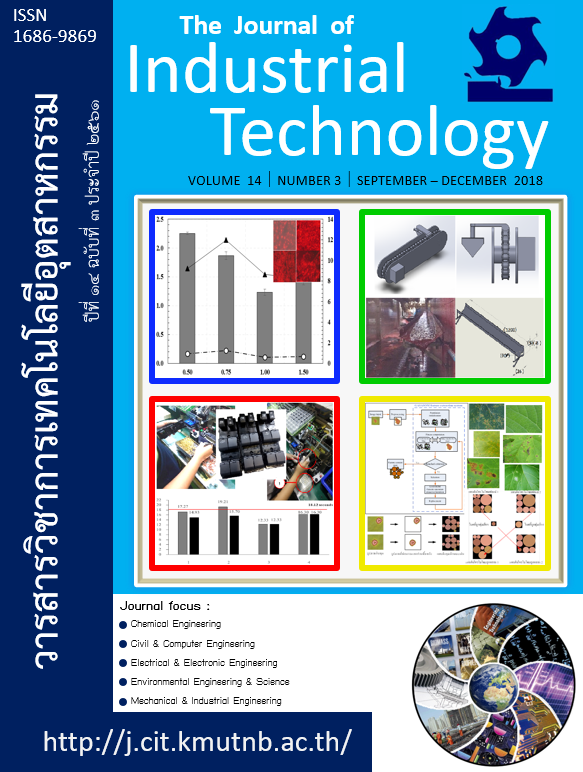(ศักยภาพการเกิดก๊าซชีวภาพจากน้ำชะขยะ กรณีศึกษาบ่อขยะไทรน้อย จังหวัดนนทบุรี) (Biochemical Methane Potential from Leachate, Case study Sainoi, Nonthaburi Province)
Keywords:
Stabilization ponds, Biochemical Methane Potential, Leachate, Natural treatment systemAbstract
This research studied the biochemical methane potential from leachate in stabilization pond, open dumping area, Sainoi Nonthaburi Province. Leachate samples were collected from 4 stabilization ponds. The finding found that organic substance (COD) from leachate can be treated with stabilization ponds. The milligrams of COD removal were decrease from 3,700 mg COD L-1 to 825 mg COD L-1, that COD removal efficiency 77%. Leachate is complex structure and non pre-treatment, so it was not easily to degradable with microorganisms. Therefore, organic substance (COD) treatment quite low efficiency. In term of biochemical methane potential from stabilization ponds were obtained 0.30, 0.25, 0.19 and 0.14 L CH4 g-1 COD removed, respectively. Thus, stabilization ponds can be simultaneous removal organic substance (COD), nitrogen compound in leachate and methane production with low cost of construction and operation.
References
[2] N. Waijarean, S. Panpuech, R. Masae and V. Srikong, “The Solid Waste Management from Fresh Market and Green Residues in Prince of Songkla University, Pattani Campus”, The Journal of Industrial Technology 14(3), 2018, pp. 33-43. (in Thai)
[3] N. Praditseree, “Fenton’s Treatment of Landfill Leachate”, Master Thesis, Technology and Environmental Management, Prince of Songkla University, Thailand. 2013.
[4] N. Naimolee, “Surface and Subsurface Water Contamination by Leachate from Disposal Site at Tambon Khlong Kwang, Amphoe Sainoi, Changwat Nonthaburi”, Master Thesis, Department of Geology, Faculty of Science, Chulalongkorn University, Thailand. 2002.
[5] D. Yu, “Landfill Leachate Treatment Case Study, SRV Atervinning, Sweden”, Master Thesis, Industrial Ecology, Royal Institute of Technology, Stockholm. 2007.
[6] Pollution Control Department, “Wastewater Management Guidelines (2nd Eds.)”, Bangkok, 2006.
[7] R.J. Kelly, “Solid Waste Biodegradation Enhancements and the Evaluation of Analytical Methods Used to Predict Waste Stability”, Blacksburg: Virginia Polytechnic Institute and State University, 2002.
[8] R.D. Vaidya, “Solid Waste Degradation, Compaction and Water Holding Capacity”, Blacksburg: Virginia Polytechnic Institute and State University, 2002.
[9] V. Sawasdee and N. Pisutpaisal, “Economic Feasible Evaluation of Biogas Production from Napier Grass”, Research Journal of Biotechnology 10, 2015, pp. 94-98.
[10] S. Kanchanasuta, U. Sitisukpoka and N. Pisutpaisal, “Comparative Performance between Heat-shocked Anaerobic Sludge and Clostridium butyricum TISTR 1032 Inocular in Biohydrogen Production from Food Waste”, Research Journal of Biotechnology 9(4), 2014,pp. 7-14.
[11] American Public Health Association-American Water Works Association-Water Pollution Control Federation (APHA-AWWA-WPCF), Standard Methods for the Examination of Water and Wastewater (20th Eds). APHA”, Washington DC. 2000.
[12] E. Athanasoulia, P. Melidis, A. Aivasidis, “Co-digestion of sewage sludge and crude glycerol from biodiesel production”, Renewable Energy 62, 2014, pp. 73-78.
[13] G.S. Kumar, J. Bharadwaj, P.L. Sruthi and M.C. Sekhar, “Removal of Ammonia Nitrogen (NH4-N) from Landfill Leachate by Chemical Treatment”, Indian Journal of Science Technology 9(30), 2016, DOI: 10.17485/ ijst/ 2016/v9i30/99174.
[14] S. Vatanyoopaisarn, “Introduction Microbiology Bangkok: King Mongkut’s University of Technology North Bangkok”, 2009, pp. 78-102. (in Thai)
[15] V. Sawasdee, “Electricity Generation and Pollution Treatment from Nitrogen-Rich Industrial Wastewater in Air-Cathode Single Chamber Microbial Fuel Cell”, Doctoral Thesis, The Joint Graduate School of Energy and Environment, King Mongkut’s University of Technology Thonburi, 2016.
[16] O. Chueawong, P. Prabhuddham and O. Phewnil, “Efficiency of Lagoon Treatment for leachate from Ban Laem Municipal Landfill Site, Ban Laem District, Phetchaburi Province”, Proceedings of 52nd Kasetsart University Annual Conference: Science, Natural Resources and Environment. (in Thai)
[17] V. Sawasdee and N. Pisutpaisal, “Simultaneous pollution treatment and electricity generation of tannery wastewater in air-cathode single chamber MFC”, International Journal of Hydrogen Energy 41, 2016, pp. 15632-15637.
[18] S. Sirianunpaibun, “Wastewater Treatment System”, Top Publishing Co., Ltd, 2014.
[19] N. Sawasdee, “Feasibility Study for Biogas Production from Napier Grass”, Master Thesis, School of Renewable Energy, Naresuan University, Thailand. 2013.


